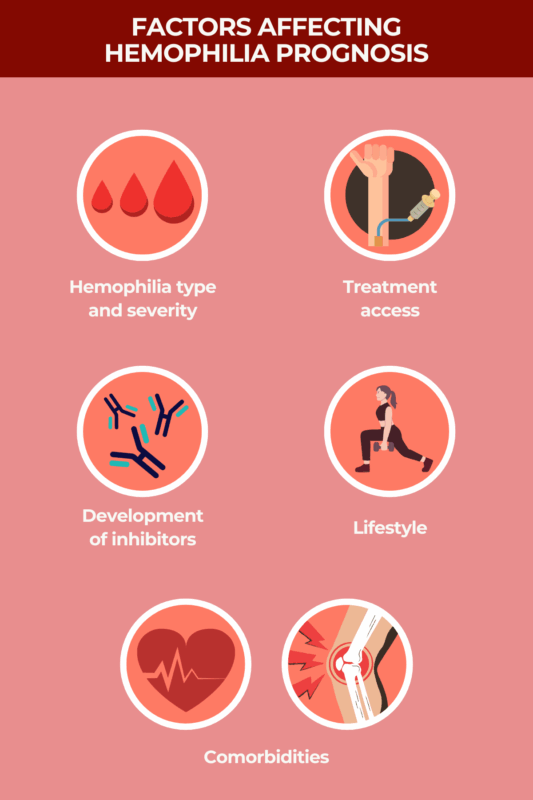Hemophilia prognosis: Life expectancy and outlook
Last updated June 13, 2025, by Lindsey Shapiro, PhD

Advances in hemophilia treatment and care over recent decades have significantly improved the long-term outlook for people living with the rare bleeding disorder and extended the hemophilia survival rate.
People with hemophilia are susceptible to spontaneous or excessive bleeding due to deficiencies in important blood-clotting proteins. The disease is usually caused by inherited genetic mutations.
The prognosis of a person living with hemophilia depends on several different factors, but with a prompt diagnosis and early initiation of a comprehensive care plan, many people are able to live full lives with a normal or near-normal life expectancy.
Factors that affect hemophilia prognosis
Understanding the elements involved in determining hemophilia prognosis is important for developing an effective approach to disease management. There are a variety of factors that can play a role, including:
- hemophilia type and severity
- treatment access
- development of inhibitors
- lifestyle
- coexisting health conditions, or comorbidities.
Type and severity of hemophilia
Hemophilia A, B, and C are hemophilia types caused by genetic mutations. Acquired hemophilia, which is very rare, is an autoimmune disease wherein the immune system erroneously attacks blood-clotting proteins.
Hemophilia is usually classified as mild, moderate, or severe depending on clotting factor levels in the blood, with low clotting protein levels being associated with more severe symptoms and a higher bleeding risk.
Disease severity is a major predictor of prognosis. People with severe hemophilia, who have a near total loss of a blood clotting factor, are more prone to spontaneous and life-threatening bleeds or long-term complications of hemophilia, including internal bleeding in the skull, muscles and joints, or other internal organs.
Hemophilia A and B are more likely to be severe than hemophilia C, which is generally considered to be a milder form of the disease. Acquired hemophilia can vary in severity.
Access to treatment
For people with severe hemophilia, access to proper treatment also has a major impact on life expectancy. The cornerstone of hemophilia A and B care is factor replacement therapy, which provides the body with a version of the missing clotting factor. These clotting factor concentrates can be used:
- on a routine basis to prevent bleeds (prophylaxis)
- as needed to control active bleeds (on-demand).
While any treatment is superior to none, it’s now recognized that routine prophylaxis leads to the best outcomes and is the standard of care for severe hemophilia. On-demand treatment can stop active bleeds, but doesn’t necessarily prevent the damage that accrues from repetitive bleeds over time. Prophylactic treatment prevents bleeds altogether, making it less likely that this damage and related life-threatening complications will occur, especially when initiated early in life.
However, access to prophylactic care can depend on region and socioeconomic factors, contributing to geographical differences in hemophilia prognosis worldwide.
Development of inhibitors
Some people on factor replacement therapies will develop inhibitors, or neutralizing antibodies against the delivered clotting protein, which renders the treatments less effective for preventing and controlling bleeds.
People who develop inhibitors are about twice as likely to be hospitalized for a bleeding complication and are at an increased risk of death.
In recent years, new treatments have been developed to manage bleeding in people who have developed inhibitors, which could help improve outcomes for this group.
Lifestyle and comorbidities
As persons with hemophilia are now living longer than ever, cardiovascular health and other age-related concerns can also impact prognosis. As in the general population, factors like obesity, diabetes, and heart disease can have a negative impact on life expectancy in a person with hemophilia. Lifestyle choices that could help preserve a person’s overall health include:
- eating a healthy diet
- practicing regular and appropriate exercise
- avoiding smoking and excessive alcohol intake.
Hemophilic arthropathy, a severe and debilitating joint disease that’s common in severe hemophilia due to recurrent joint bleeds, can also make it more difficult to be active, increasing the risk of cardiovascular problems in people with hemophilia. Managing hemophilia complications like joint disease is thus critical.

Hemophilia life expectancy with treatment
Historically, hemophilia was considered a fatal disease, and many people did not survive into adulthood. In the early 1900s, the average life expectancy for a person with severe hemophilia was not more than 13 years, and by the 1960s, it was still less than 20.
The emergence of factor replacement therapies dramatically changed this trajectory, and hemophilia life expectancy has continuously improved with modernizations in treatment and care. Decreases in hepatitis and HIV infections, which used to be higher due to poor screening of blood-derived treatment products, have also contributed to reducing the death rates.
Now, when treatment and comprehensive care are started at a young age, people with severe hemophilia can live almost as long as people without hemophilia. Studies show that in developed countries, the median life expectancy for a treated person with severe hemophilia A or B is within 10 years of what’s seen in the general population.
People with moderate or mild hemophilia, including hemophilia C, have a life expectancy that’s close to that observed in the general population.
Advances in hemophilia treatment and their impact on prognosis
The best treatments for hemophilia prognosis depend on the individual. Recent hemophilia treatment advances beyond standard replacement therapies have the potential to enable people with hemophilia to live longer and better lives.
- Extended half-life replacement therapies are designed to last longer in the bloodstream than standard products, which could help maintain higher blood levels of clotting factors for more stable and sustained bleed control.
- Gene therapy is a one-time treatment approach that provides the body with a version of the gene needed to produce the missing blood-clotting protein, while potentially eliminating the need for routine replacement therapies.
- Nonfactor therapies work in different ways to restore normal blood clotting, which could offer a means for bleed control in people who have developed inhibitors against standard treatments.
Ongoing research is continuously focused on developing more effective and safer treatment options for hemophilia, which could improve the outlook in years to come even further.
Quality of life considerations
While modern treatments have drastically improved hemophilia prognosis, there is no cure for the bleeding disorder and it requires lifelong care. There are a variety of steps a person can take to promote a good quality of life and make living with hemophilia easier, including:
- practicing mobility and joint care exercises to improve hemophilia and joint health
- exercising and eating a balanced diet to maintain a healthy weight and reduce joint strain
- implementing appropriate pain-management strategies
- maintaining good mental health and emotional well-being
- staying in regular contact with a multidisciplinary healthcare team.
Ultimately, with a comprehensive care plan initiated as early as possible, people with hemophilia can live full and relatively normal lives.
Hemophilia News Today is strictly a news and information website about the disease. It does not provide medical advice, diagnosis or treatment. This content is not intended to be a substitute for professional medical advice, diagnosis, or treatment. Always seek the advice of your physician or other qualified health provider with any questions you may have regarding a medical condition. Never disregard professional medical advice or delay in seeking it because of something you have read on this website.
Recent Posts
- For women with hemophilia, speaking up is an act of courage
- Early Hemlibra use prevents bleeding in babies with hem A
- After the dark days of hemophilia, I’m thankful for peace at home
- Women with hemophilia may feel different, but shouldn’t be ashamed
- Preclinical data bring human trial launch closer for MGX-001






